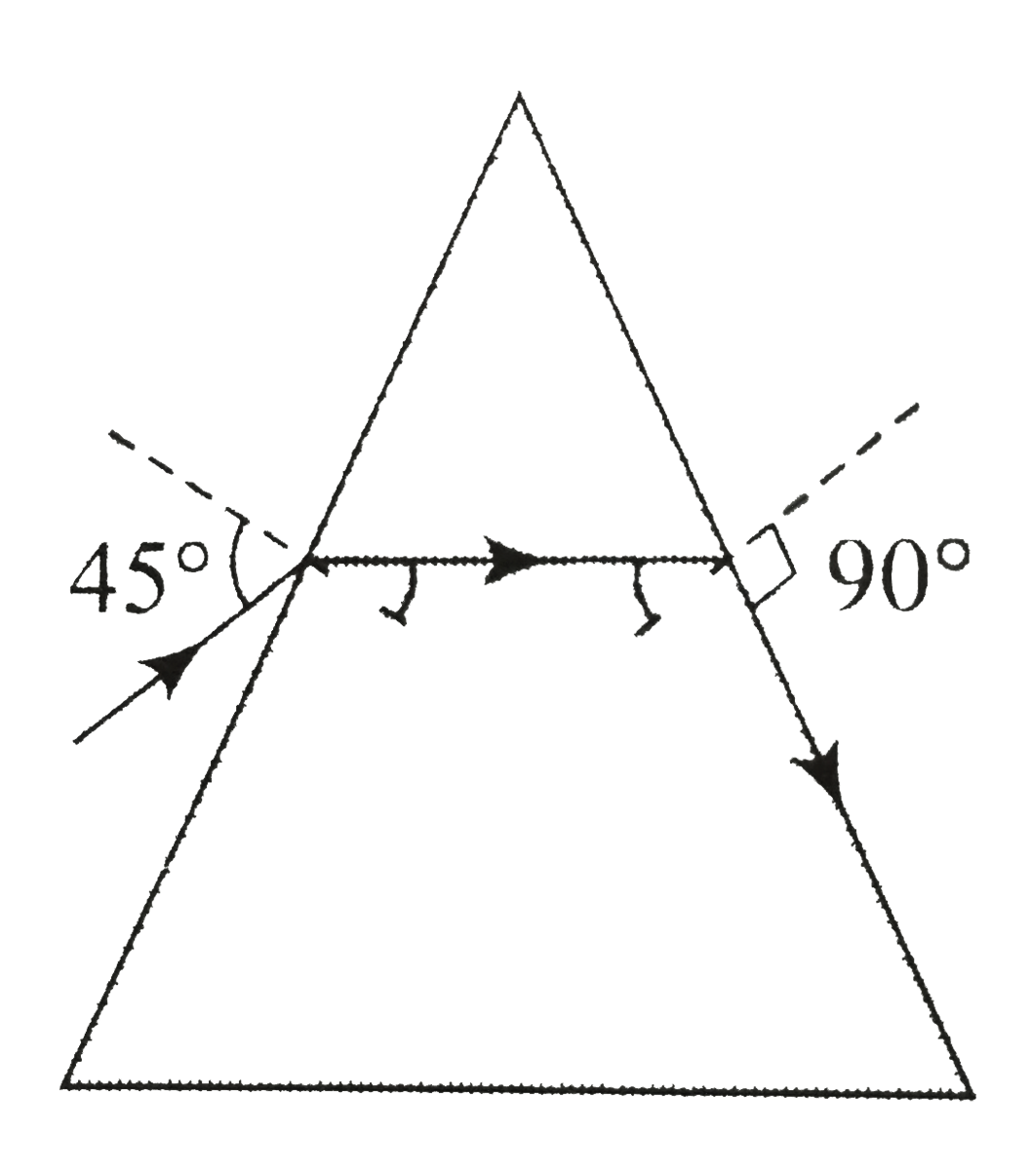The light ray is incidence at angle of 60∘ on a prism of angle 45∘ . When the light ray falls on the other surface at 90∘ , the refractive index of the material of prismμ and the angle of deviation δ are given by
μ=√2,δ=30∘
μ=1.5,δ=15∘
μ=√32,δ=30∘
μ=√32,δ=15∘
The correct Answer is:D
To solve the problem step by step, we will determine the refractive index (μ) of the prism and the angle of deviation (δ) based on the given information.
Step 1: Identify the angles
- The angle of incidence (I) is given as 60∘.
- The angle of the prism (A) is given as 45∘.
- The angle of refraction at the second surface (r2) is 90∘.
Step 2: Use the property of the prism
According to the property of a prism, the sum of the angles of refraction at the two surfaces is equal to the angle of the prism:
r1+r2=A
Given that r2=0∘ (because the ray exits at 90∘), we can write:
r1+0=45∘⟹r1=45∘
Step 3: Apply Snell's Law at the first surface
Using Snell's Law at the first surface, we have:
μ1sinI=μ2sinr1
Where:
- μ1=1 (for air)
- I=60∘
- r1=45∘
- μ2=μ (refractive index of the prism)
Substituting the values, we get:
1⋅sin(60∘)=μ⋅sin(45∘)
Step 4: Solve for the refractive index (μ)
We know:
- sin(60∘)=√32
- sin(45∘)=1√2
Substituting these values into the equation:
√32=μ⋅1√2
Rearranging gives:
μ=√321√2=√32⋅√2=√62
Step 5: Calculate the angle of deviation (δ)
The angle of deviation (δ) can be calculated using the formula:
δ=(μ−1)⋅A
Substituting the values:
δ=(√62−1)⋅45∘
Step 6: Simplify the expression
Calculating √62−1:
δ=(√6−22)⋅45∘
Step 7: Final calculation
Now, we can compute the numerical value of δ:
δ=√6−22⋅45∘
Conclusion
Thus, the refractive index of the prism is:
μ=√62
And the angle of deviation is:
δ=15∘
- The angle of incidence (I) is given as 60∘.
- The angle of the prism (A) is given as 45∘.
- The angle of refraction at the second surface (r2) is 90∘.
According to the property of a prism, the sum of the angles of refraction at the two surfaces is equal to the angle of the prism:
r1+r2=A
Given that r2=0∘ (because the ray exits at 90∘), we can write:
r1+0=45∘⟹r1=45∘
Using Snell's Law at the first surface, we have:
μ1sinI=μ2sinr1
Where:
- μ1=1 (for air)
- I=60∘
- r1=45∘
- μ2=μ (refractive index of the prism)
1⋅sin(60∘)=μ⋅sin(45∘)
We know:
- sin(60∘)=√32
- sin(45∘)=1√2
√32=μ⋅1√2
μ=√321√2=√32⋅√2=√62
The angle of deviation (δ) can be calculated using the formula:
δ=(μ−1)⋅A
Substituting the values:
δ=(√62−1)⋅45∘
Calculating √62−1:
δ=(√6−22)⋅45∘
Now, we can compute the numerical value of δ:
δ=√6−22⋅45∘
Thus, the refractive index of the prism is:
μ=√62
And the angle of deviation is:
δ=15∘
Topper's Solved these Questions
- BOOK - CENGAGE PHYSICS ENGLISHCHAPTER - RAY OPTICSEXERCISE - DPP 1.612videos
RAY OPTICS
- BOOK - CENGAGE PHYSICS ENGLISHCHAPTER - RAY OPTICSEXERCISE - DPP 1.415videos
RAY OPTICS
- BOOK - CENGAGE PHYSICS ENGLISHCHAPTER - PHOTOELECTRIC EFFECTEXERCISE - Integer Type4videos
PHOTOELECTRIC EFFECT
- BOOK - CENGAGE PHYSICS ENGLISHCHAPTER - SOURCES OF MAGNETIC FIELDEXERCISE - single correct Ansewer type12videos
SOURCES OF MAGNETIC FIELD
Similar Questions
A ray of light is incident at 60∘ on one face of a prism of angle 30∘ and the emergent ray makes 30∘ with the incident ray. The refractive index of the prism is
View SolutionA ray of light is incident at small angle I on the surface of prism of small angle A and emerges normally from the oppsite surface. If the refractive index of the material of the prism is mu, the angle of incidence is nearly equal to
View Solution
Knowledge Check
- Question 1 - Select One
A ray of light is incident at 60∘ on one face of a prism of angle 30∘ and the emergent ray makes 30∘ with the incident ray. The refractive index of the prism is
A1.732B1.414C1.5D1.33 - Question 2 - Select One
A ray of light is incident at small angle I on the surface of prism of small angle A and emerges normally from the oppsite surface. If the refractive index of the material of the prism is mu, the angle of incidence is nearly equal to
AAμBA2μCμADμA2
A ray of light is incident at small angle I on the surface of prism of small angle A and emerges normally from the oppsite surface. If the refractive index of the material of the prism is mu, the angle of incidence is nearly equal to
View SolutionA ray of light is incident at 65∘ on one face of a prism of angle of 30∘ and the emergent ray makes 35∘ with the incident ray. The refractive index of the prism is:
View SolutionA ray of monochromatic light is incident on one refracting face of a prism of angle 75∘. It passes thorugh the prism and is incident on the other face at the critical angle. If the refractive index of the material of the prism is √2, the angle of incidence on the first face of the prism is
View SolutionA ray is ihncident at an angle of incidence ii on one surface of a prism of small angle A and emerge normally from opposite surface. If the refractive index of the material of prism is μ. the angel of incidance I is nearly equal to
View SolutionIn an isosceles prism of angle 45∘, it is found that when the angle of incidence is same as the prism angle, the emergen ray grazes the emergent surface.
Find the refractive index of the material of the prism. For what angle of incidenc, the angle of deviation will be minimum?
 View Solution
View SolutionA ray of monochromatic light is incident on the refracting face of a prism (angle 75∘0 . It passes through the prism and is incident on the other face at the critical angle. If the refractive index of the prism is √2 , then the angle of incidence on the first of the prism is
View Solution

